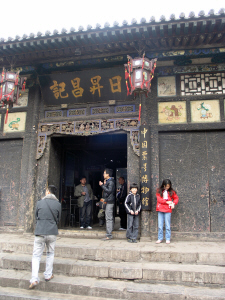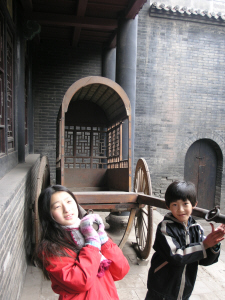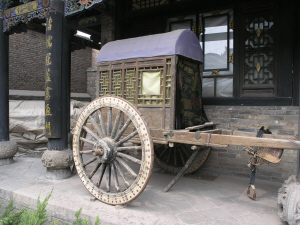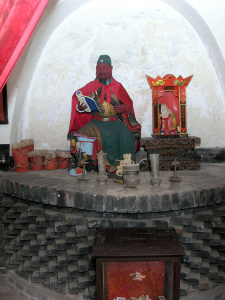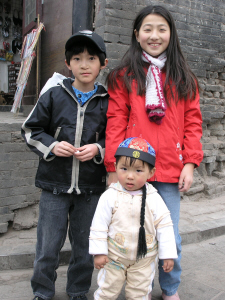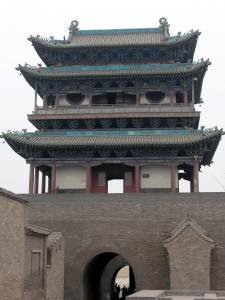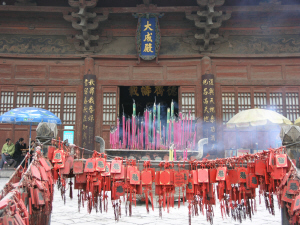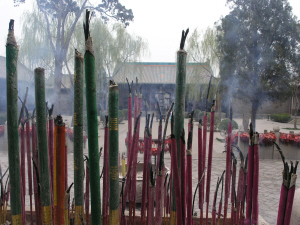 |
|||||||||||||||||||||||||||||||||||||||||||||||||||||||||||||||||||||||||||
We woke at Taiyuan station at 6am after a pretty good nights sleep – although we almost fell out of our bunks every time the train stopped. We arrived in Pingyao on time at 7:31 and got off with all the other foreigners that were on the train – about 20 in all and a hundred or so Chinese. The hotel had sent a taxi to pick us up, and somebody with a Dutch sounding name who evidently wasn't on the train.
It was the first time we were up so early whilst in China, and it felt much
colder than Beijing. We drove through a pretty drub part of town before reaching
the walled city and then through some very narrow streets before reaching the
hotel - the Tianyuankui Hotel. We were given a very warm welcome at the hotel - there seemed to be Chinese waitresses and check-in
people everywhere. We were shown to our room, through small courtyards and
passageways. We had two interconnected rooms - ours with a massive bed that
filled 75% of the room and Yanmei and Daji with two single beds. This was going
to be the first time that Yanmei and Daji slept in their own room and we were
interested to see how it went.
We breakfasted - pancakes, fruit and tea seemed to be the normal breakfast. The waitresses took an immediate interest in Yanmei and Daji and asked lots of questions. They helped us plan our day and told us where we could could buy tickets to see the city - in Pingyao you buy a single ticket covering all the sights. The ticket costs 120 RMB for adults and 60 RMB for children, and can be used over 2 days - as long as one remembers to tell them it's for two days, which they write on the ticket, otherwise it's only for one day.
Pingyao is situated in Shanxi province and is designated by UNESCO as a World
Cultural Heritage site in 1997 due to its many historical buildings where the
shop fronts and buildings largely retain their historical appearance; and not
least the 6,5km wall surrounding the city, built in 1370. As the city prospered
and it became unsafe to transport money banks were set to enable customers to
pay locally, instead of sending money with for example a courier. The
Rishengchang Bank in Pingyao is considered as the first bank in China.
The Old Town of Pingyao was constructed according to the
traditional planning and building style of the Han ethnic group, and was
designed according to the functions of its different parts. Four large streets,
eight smaller ones, and 72 lanes make a neat grid. The city is also known as the
Turtle City. The south and north gates represent a turtle’s head and tail, and the four gates
on the east and west represent four legs, the two wells just beyond southern
gate are the eyes. A web of alleys links the main streets in such a way that
even the layout of the town resembles the markings on a turtle shell. Symmetrically arranged along
an axis, the private houses were constructed either in the style of courtyard
houses or in the style of manmade-cave houses, all with local features. Today, Pingyao
still has 3,797 courtyard houses, 400 of them especially well preserved.
There are no cars in Pingyao’s winding alleys; pedestrians and bicycles crowd the lanes.
We left the hotel at around 10am, it was still cold with a light cloud and of
course the narrow streets meant that we primarily walked in the shade - which
was probably great in summer, but not just now. The city was coming to life as
we walked along Southern Main St. and then Western Main St. We found the ticket
booth, and helped by a hopeful tourist guide, purchased the necessary tickets.
We started our visit to the many sights - the Rishengchang Bank was our first
stop - the first bank in China and now a museum for banking. Covering an area
of 1,400 square meters and established in 1823, it has twenty-one buildings around
three courtyards on a north-south central axis. The counters are arranged on
either side of the front yard. The three rooms in the middle courtyard house the
exchange centre, where primary operations were carried out. Guest rooms are to
be found in the wings beside the main hall. In the rear court there are five
main halls. As an important financial institution, Rishengchang devised many initiatives
for its banking system. For example, just opposite the door hangs a tablet
inscribed with a few lines of poetry. In actual fact they are some of the
earliest cryptograph characters that, like Morse code, represent a series of
corresponding numbers. The cipher was constantly changed so as to restrict its
interpretation to just a privileged few. Moreover, other security techniques,
such as seals, watermarks, and handwriting of certain styles, were applied to
the drafts issued by the bank. For almost more than a century, Rishengchang
thrived with increased deposits until it went out of business in the early years
of the Chinese Republic.
As the banking business thrived in Pingyao - at one time more than 20 banks had
their main offices here, so did the armed escort business, with many of the
residences being the head offices of the companies that escorted the money
throughout China.
To the untrained eye, as ours, the residences we visited with buildings surrounding
courtyards, looked fairly similar. We decided to focus on the temples which
usually are more colourful. As we walked along the streets we could see the
different building with their wood fronts and engravings. Along the central
street there were over 220 banks, inns, pawn shops, Chinese herb shops, silk
shops, tea stores, antique stores and restaurants at that glorious time - during Pingyao's prime period. Today many are turned into
tourist shops, hotels, bars and restaurants, as Pingyao is a city that attracts
many tourists - mostly Chinese, but also a fair few foreigners. We were greeted
by many shouts of “come look here” as we walked by – but
just as many stares, mouth dropping and pointed fingers as we walked past with
Yanmei and Daji.
In April Pingyao is grey and dusty, it would be nice with a few more flowers and
trees, and probably a shower or two to wask the dust and dirt away.
We stopped for coffee and hot chocolate at a western bar – the bar was decorated
like a western ranch. Lots of Chinese took pictures on the outside, but few
ventured in – even though I think the idea was more addressed the Chinese than
Westerners, it was more or less only Westerners that went inside.
In the afternoon we visited the The Ancient Government Building which housed a
prison and a number of barbaric torture instruments and stocks, as well as the
site where public trials took place. The complex contained other government
buildings for tax collection and the judges quarters. Not least the torture
instruments interested Daji. We also visited the The Former Residence of Lei
Lutai built during the end of 18th century and the beginning of 19th century and
consisting of four courtyards and associated buildings. Lei Lutai was a business
tycoon in Qing Dynasty because he was one of the founders of Rishengchang and
was a major figure in China's financial history.
Our last stop was the Confucian Temple, once also a school where bureaucrats
studied before taking their exams. There are 87 sculptures of Confucius and his
disciples at the site, which is the largest number in any temple. Confucius is regarded as the forefather of Chinese
culture during the past 2,500 plus years and temples worshipping him are found
throughout ancient China. The temple consists of 112 buildings, the main building
built in 1163. After seeing the grey streets and dark residences, it was nice to
see some grass, trees and colour, that one always finds in Chinese temples.
We were back at the hotel around 5pm tired and a bit cold, so we eat at the
hotel – where the food turned out to be excellent – and Yanmei and Daji got even
more attention.
Lene played cards with Yanmei and Daji, Steven updated our diary and answered a
couple of mails.
We slept early and long – Yanmei and Daji sleeping
alone in a hotel for the first time.
|
|||||||||||||||||||||||||||||||||||||||||||||||||||||||||||||||||||||||||||









